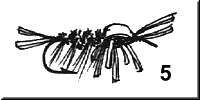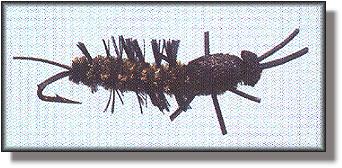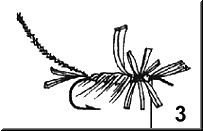|
5. Spiral the chenille forward through the hen feather, past
the wingcase, and through the legs to a point just behind the
hook eye. Secure the chenille with two extra turns of tying
thread and cut off the excess. Bring the foam forward to
form the windcase and secure it just behind the eye.
Whip-finish to form a small head, being careful not to
cut the pinchers.

6. Bend the thorax of the fly up slightly. Trim the tails of the
fly, legs, pinchers and gills to length. Although they are quite
short on the natural, a little extra length add fish-attracting movement
to the fly. Place a touch of lacquer on the whip-finish. Optimal
brown highlights can be applied to the top and bottom of the
abdomen with a waterproof marking pen.
Fishing Suggestions
Since the preferred habitat of the hellgrammite (Dobson fly larva)
is in well aerated riffles, that is where I concentrate my efforts. Using
short line (slow and deep) nymphing technique I cover the riffle's
entire length in a series of short drifts paying partifular attention to
holding water behind rocks, head of pools, etc. Although the fly
itself, is weighted extra weight, split-shot is often needed. Change
the amount of weight often to match changing water flows as you
move through the riffle. An occasional tap of the split shot against
the top of rocks as the fly moves downstreams serves to identify
a good drift. No taps and you're probably too far off the bottom.
~ Floyd N. Franke Phone: (607) 498-4508.
|









